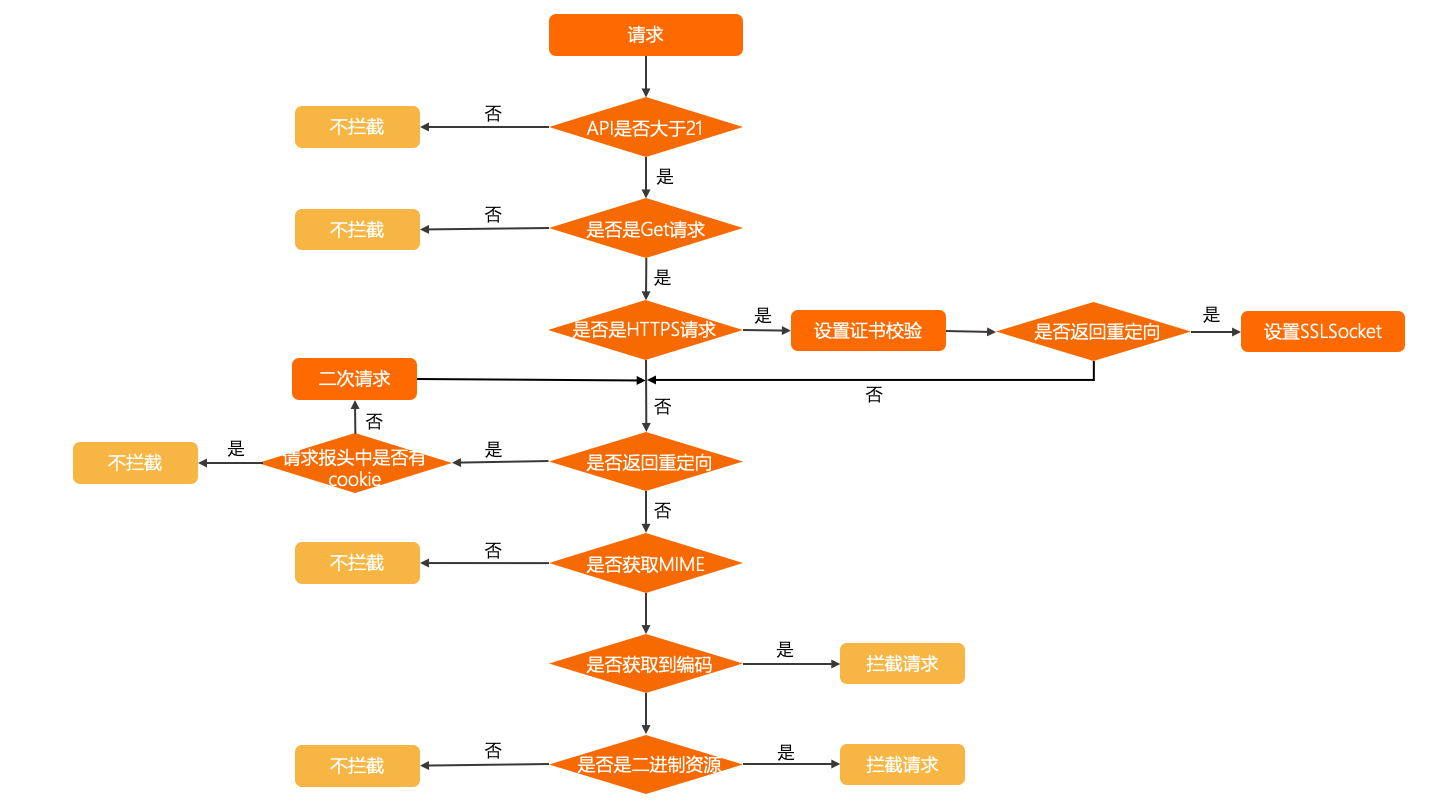本文档未Android WebView场景下接入HTTPDNS的参考方案,提供的相关代码也为参考代码,非线上生产环境正式代码,建议您仔细阅读本文档,进行合理评估后再进行接入。
由于Android生态碎片化严重,各厂商也进行了不同程度的定制,建议您灰度接入,并监控线上异常,有问题欢迎您随时通过技术支持向我们反馈,方便我们及时优化。
当前最佳实践文档只针对结合使用时,如何使用HTTPDNS解析出的IP,关于HTTPDNS本身的解析服务,请先查看Android SDK接入。
背景说明
阿里云HTTPDNS是避免DNS劫持的一种有效手段,在许多特殊场景如Android端HTTPS(含SNI)业务场景:IP直连方案、Android端HTTPDNS+OkHttp接入指南等都有最佳实践,但在webview场景下却一直没完美的解决方案。
但这并不代表在WebView场景下我们完全无法使用HTTPDNS,事实上很多场景依然可以通过HTTPDNS进行IP直连,本文旨在给出Android端HTTPDNS+WebView最佳实践供用户参考。
代码示例
HTTPDNS+WebView最佳实践完整代码请参考WebView+HTTPDNS Android Demo。
拦截接口说明
void setWebViewClient (WebViewClient client);WebView提供了setWebViewClient接口对网络请求进行拦截,通过重载WebViewClient中的shouldInterceptRequest方法,我们可以拦截到所有的网络请求:
public class WebViewClient{
// API < 21
public WebResourceResponse shouldInterceptRequest(WebView view,
String url) {
...
}
// API >= 21
public WebResourceResponse shouldInterceptRequest(WebView view,
WebResourceRequest request) {
...
}
......
}shouldInterceptRequest有两个版本:
当
API < 21时,shouldInterceptRequest方法的版本为:public WebResourceResponse shouldInterceptRequest(WebView view, String url)此时仅能获取到请求URL,请求方法、头部信息以及body等均无法获取,强行拦截该请求可能无法能到正确响应。所以当
API < 21时,不对请求进行拦截:public WebResourceResponse shouldInterceptRequest(WebView view, String url) { return super.shouldInterceptRequest(view, url); }当
API >= 21时,shouldInterceptRequest提供了新版:public WebResourceResponse shouldInterceptRequest(WebView view, WebResourceRequest request)其中
WebResourceRequest结构为:public interface WebResourceRequest { Uri getUrl(); // 请求URL boolean isForMainFrame(); // 是否由主MainFrame发出的请求 boolean hasGesture(); // 是否是由某种行为(如点击)触发 String getMethod(); // 请求方法 Map<String, String> getRequestHeaders(); // 头部信息 }
可以看到,在API >= 21时,在拦截请求时,可以获取到如下信息:
请求URL
请求方法:POST, GET…
请求头
实践使用
WebView场景下的请求拦截逻辑如下所示:

仅拦截GET请求
设置头部信息
HTTPS请求证书校验
SNI场景
重定向
MIME&Encoding
仅拦截GET请求
由于WebResourceRequest并没有提供请求body信息,所以只能拦截GET请求,不能拦截POST:
public WebResourceResponse shouldInterceptRequest(WebView view, WebResourceRequest request) {
String scheme = request.getUrl().getScheme().trim();
String method = request.getMethod();
Map<String, String> headerFields = request.getRequestHeaders();
// 无法拦截body,拦截方案只能正常处理不带body的请求;
if ((scheme.equalsIgnoreCase("http") || scheme.equalsIgnoreCase("https"))
&& method.equalsIgnoreCase("get")) {
......
} else {
return super.shouldInterceptRequest(view, reqeust);
}设置头部信息
public WebResourceResponse shouldInterceptRequest(WebView view, WebResourceRequest request) {
......
URL url = new URL(request.getUrl().toString());
conn = (HttpURLConnection) url.openConnection();
// 接口获取IP
String ip = httpdns.getIpByHostAsync(url.getHost());
if (ip != null) {
// 通过HTTPDNS获取IP成功,进行URL替换和HOST头设置
Log.d(TAG, "Get IP: " + ip + " for host: " + url.getHost() + " from HTTPDNS successfully!");
String newUrl = path.replaceFirst(url.getHost(), ip);
conn = (HttpURLConnection) new URL(newUrl).openConnection();
// 添加原有头部信息
if (headers != null) {
for (Map.Entry<String, String> field : headers.entrySet()) {
conn.setRequestProperty(field.getKey(), field.getValue());
}
}
// 设置HTTP请求头Host域
conn.setRequestProperty("Host", url.getHost());
}
}HTTPS请求证书校验
如果拦截到的请求是HTTPS请求,需要进行证书校验:
if (conn instanceof HttpsURLConnection) {
final HttpsURLConnection httpsURLConnection = (HttpsURLConnection)conn;
// https场景,证书校验
httpsURLConnection.setHostnameVerifier(new HostnameVerifier() {
@Override
public boolean verify(String hostname, SSLSession session) {
String host = httpsURLConnection.getRequestProperty("Host");
if (null == host) {
host = httpsURLConnection.getURL().getHost();
}
return HttpsURLConnection.getDefaultHostnameVerifier().verify(host, session);
}
});
}SNI场景
如果请求涉及到SNI场景,需要自定义SSLSocket,对SNI场景不熟悉的用户可以参考SNI:
TlsSniSocketFactory sslSocketFactory = new TlsSniSocketFactory((HttpsURLConnection) conn);
// sni场景,创建SSLScocket
((HttpsURLConnection) conn).setSSLSocketFactory(sslSocketFactory);
......
class TlsSniSocketFactory extends SSLSocketFactory {
private final String TAG = "TlsSniSocketFactory";
HostnameVerifier hostnameVerifier = HttpsURLConnection.getDefaultHostnameVerifier();
private HttpsURLConnection conn;
public TlsSniSocketFactory(HttpsURLConnection conn) {
this.conn = conn;
}
......
@Override
public Socket createSocket(Socket plainSocket, String host, int port, boolean autoClose) throws IOException {
String peerHost = this.conn.getRequestProperty("Host");
if (peerHost == null)
peerHost = host;
Log.i(TAG, "customized createSocket. host: " + peerHost);
InetAddress address = plainSocket.getInetAddress();
if (autoClose) {
// we don't need the plainSocket
plainSocket.close();
}
// create and connect SSL socket, but don't do hostname/certificate verification yet
SSLCertificateSocketFactory sslSocketFactory = (SSLCertificateSocketFactory) SSLCertificateSocketFactory.getDefault(0);
SSLSocket ssl = (SSLSocket) sslSocketFactory.createSocket(address, port);
// enable TLSv1.1/1.2 if available
ssl.setEnabledProtocols(ssl.getSupportedProtocols());
// set up SNI before the handshake
if (Build.VERSION.SDK_INT >= Build.VERSION_CODES.JELLY_BEAN_MR1) {
Log.i(TAG, "Setting SNI hostname");
sslSocketFactory.setHostname(ssl, peerHost);
} else {
Log.d(TAG, "No documented SNI support on Android <4.2, trying with reflection");
try {
java.lang.reflect.Method setHostnameMethod = ssl.getClass().getMethod("setHostname", String.class);
setHostnameMethod.invoke(ssl, peerHost);
} catch (Exception e) {
Log.w(TAG, "SNI not useable", e);
}
}
// verify hostname and certificate
SSLSession session = ssl.getSession();
if (!hostnameVerifier.verify(peerHost, session))
throw new SSLPeerUnverifiedException("Cannot verify hostname: " + peerHost);
Log.i(TAG, "Established " + session.getProtocol() + " connection with " + session.getPeerHost() +
" using " + session.getCipherSuite());
return ssl;
}
}重定向
如果服务端返回重定向,此时需要判断原有请求中是否含有cookie:
如果原有请求报头含有cookie,因为cookie是以域名为粒度进行存储的,重定向后cookie会改变,且无法获取到新请求URL下的cookie,所以放弃拦截。
如果不含cookie,重新发起二次请求。
int code = conn.getResponseCode();
if (code >= 300 && code < 400) {
if (请求报头中含有cookie) {
// 不拦截
return super.shouldInterceptRequest(view, request);
}
//临时重定向和永久重定向location的大小写有区分
String location = conn.getHeaderField("Location");
if (location == null) {
location = conn.getHeaderField("location");
}
if (!(location.startsWith("http://") || location
.startsWith("https://"))) {
//某些时候会省略host,只返回后面的path,所以需要补全url
URL originalUrl = new URL(path);
location = originalUrl.getProtocol() + "://"
+ originalUrl.getHost() + location;
}
Log.e(TAG, "code:" + code + "; location:" + location + ";path" + path);
发起二次请求
} else {
// redirect finish.
Log.e(TAG, "redirect finish");
......
}MIME&Encoding
如果拦截网络请求,需要返回一个WebResourceResponse:
public WebResourceResponse(String mimeType, String encoding, InputStream data) ;创建WebResourceResponse对象需要提供:
请求的MIME类型
请求的编码
请求的输入流
其中请求输入流可以通过URLConnection.getInputStream()获取到,而MIME类型和encoding可以通过请求的ContentType获取到,即通过URLConnection.getContentType(),如:
text/html;charset=utf-8但并不是所有的请求都能得到完整的contentType信息,此时可以参考如下策略:
String contentType = conn.getContentType();
String mime = getMime(contentType);
String charset = getCharset(contentType);
// 无MIME类型的请求不拦截
if (TextUtils.isEmpty(mime)) {
return super.shouldInterceptRequest(view, request);
} else {
if (!TextUtils.isEmpty(charset)) {
// 如果同时获取到MIME和charset可以直接拦截
return new WebResourceResponse(mime, charset, connection.getInputStream());
} else {
//获取不到编码信息
// 二进制资源无需编码信息,可以进行拦截
if (isBinaryRes(mime)) {
Log.e(TAG, "binary resource for " + mime);
return new WebResourceResponse(mime, charset, connection.getInputStream());
} else {
// 非二进制资源需要编码信息,不拦截
Log.e(TAG, "non binary resource for " + mime);
return super.shouldInterceptRequest(view, request);
}
}
}
private boolean isBinaryRes(String mime) {
// 可进行扩展
if (mime.startsWith("image")
|| mime.startsWith("audio")
|| mime.startsWith("video")) {
return true;
} else {
return false;
}
}总结
场景 | 总结 |
不可用场景 |
|
可用场景 | 前提条件:
可用场景:
|